Related Research Articles
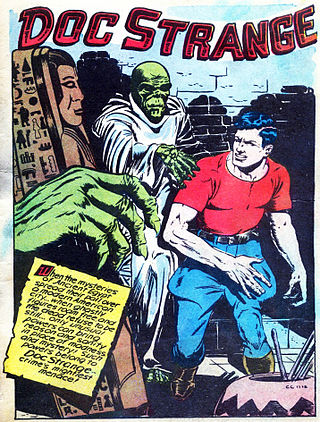
Doc Strange is a Golden Age comic book superhero who originally appeared in Thrilling Comics #1 in February 1940. The character continued in Thrilling Comics until issue #64. He also appeared in America's Best Comics #1-23 and 27.

Cat-Man and Kitten are a pair of fictional superhero characters created by artists Irwin Hasen (Cat-Man) and Charles M. Quinlan (Kitten) with unknown writers. Cat-Man was first published in 1940 by various Frank Z. Temerson companies. Due to circumstances during World War II, an altered version of Cat-Man was published in Australia and reprinted in the 1950s. AC Comics later revived the characters in the 1980s.
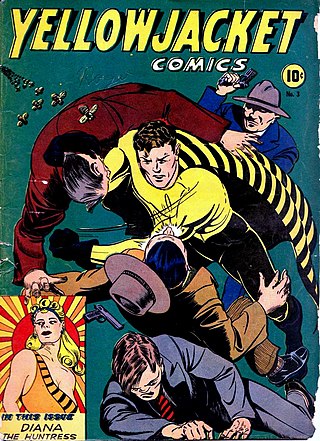
Yellowjacket is a fictional super-hero, and the first to be published by the company that would become Charlton Comics. He first appeared in Yellowjacket Comics #1.
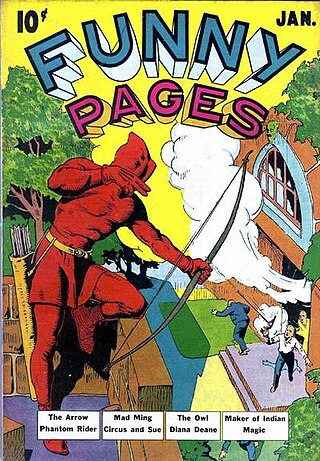
The Arrow is a fictional superhero created during the Golden Age of Comic Books. He was the first superhero published by Centaur Publications.
The Green Mask is the name of two comic book superheroes, both published by Fox Feature Syndicate. Both are in the public domain with some of the original stories having been reprinted by AC Comics.

The Bouncer is a fictional superhero who appeared in comic books published by Fox Feature Syndicate. The Bouncer had no secret identity, but was in reality a statue of the Greek mythological figure Antaeus. The statue had been sculpted by Adam Anteas, Jr., a descendant of the very same legendary figure. Like his Greek ancestor, Anteas Jr. gained power when in contact with the earth. Anteas Jr.'s power was that he bounced back whenever he struck the ground; the harder he hit, the higher he bounced. Like his ancestor, he lost his power when out of contact with the ground.

Samson is a superhero who appeared in comic books published by Fox Feature Syndicate. He first appeared in Fantastic Comics #1. The writer was uncredited, but is believed to be Will Eisner; the artist was Alex Blum, using the pseudonym "Alex Boon".
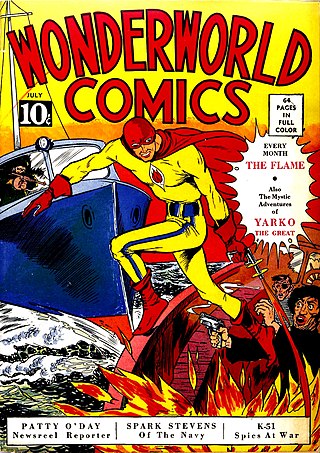
The Flame is a superhero that appeared in American comic books published by Fox Feature Syndicate. The Flame first appeared in Wonderworld Comics #3 and was created by writer Will Eisner and artist Lou Fine. The Flame became Wonderworld's primary character.

Miss Masque is a fictional masked crime-fighter. She originally appeared in comic books published by Nedor Comics, and was later revived by AC Comics, America's Best Comics, and Dynamite Entertainment.

Pyroman is a fictional superhero that appeared in comic books published by Nedor Comics. His first appearance was in Startling Comics #18, with art by Jack Binder. This character was later revived by both AC Comics and America's Best Comics.
The Scarab is a fictional superhero from the Golden Age of Comics. He first appeared in Startling Comics #34, published by Nedor Comics. The character was later revived by writer Alan Moore for America's Best Comics.
The Moth is the name of two American comic-book superhero characters. The first was created by artist Jim Mooney and an unknown writer for Fox Feature Syndicate in 1940, during the period fans and historians call the Golden Age of Comic Books. The second was created by writer-artist Steve Rude in 1998 for Dark Horse Comics.

The Target and the Targeteers are fictional characters, a trio of superheroes who first appeared in 1940, in Target Comics from Novelty Press.
The Owl is a fictional superhero that first appeared in Dell Comics' Crackajack Funnies #25, continuing until #43.

The Black Owl is the name of two fictional superhero characters. Both appeared in the Prize Publications title Prize Comics in the 1940s.
Yank & Doodle is a pair of superheroes who first appeared in the Prize Publications title Prize Comics in August 1941. They were revived by Dynamite Entertainment in the 2000s.

Silver Streak is a fictional superhero character created by Joe Simon that first appeared in Silver Streak Comics #3, from Lev Gleason Publications. He is believed to be the second-ever comic book superhero whose primary power is speed; All-American Publications' The Flash preceded him by two months. However, Silver Streak beat out National Allied Publications' Johnny Quick as the first superhero whose two powers were speed and flight. Silver Streak has a kid sidekick called "Mercury" ; he is also assisted by a falcon named "Whiz".
Captain Courageous is a fictional superhero character who first appeared in Banner Comics #3 from Ace Comics.
Lash Lightning is a fictional superhero character who first appeared in Sure-Fire Comics #1 from Ace Comics, which was renamed Lightning Comics with issue #4 to take advantage of the new character's popularity. Originally called Flash Lightning, the character's name was changed to Lash Lightning in issue #7 to avoid confusion with DC Comics' the Flash.
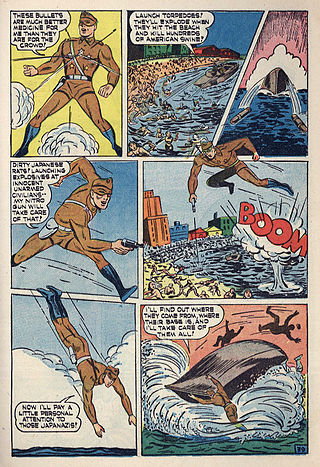
The Unknown Soldier is a fictional superhero character who first appeared in Our Flag Comics #1 from Ace Comics. The comic was devoted to patriotic superheroes, and also included Captain Victory and the Three Cheers.
References
- ↑ Markstein, Don. "Hydroman". Don Markstein's Toonopedia. Retrieved 2 April 2020.
- ↑ Benton, Mike (1992). Superhero Comics of the Golden Age: The Illustrated History. Dallas: Taylor Publishing Company. pp. 111–112. ISBN 0-87833-808-X . Retrieved 15 January 2020.
- ↑ Mougin, Lou (2020). Secondary Superheroes of Golden Age Comics. McFarland & Co. pp. 396–397. ISBN 9781476638607.
- ↑ Yoe, Craig (2016). Super Weird Heroes:Outrageous But Real!. Yoe Books/IDW. p. 170. ISBN 978-1631407451.
- ↑ Nevins, Jess (2013). Encyclopedia of Golden Age Superheroes. High Rock Press. p. 132. ISBN 978-1-61318-023-5.